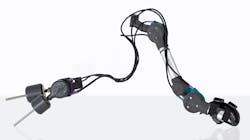Desktop 3D Printer Produces Arm Brace for Child with SMA
A child living in Poland was the recipient of a 3D-printed hand exoskeleton that would help him to perform everyday tasks while living with spinal muscular atrophy. Spinal muscular atrophy makes it difficult for people to move their arms and legs without the help of an assistive brace. The mother of the child called 3D designer, Bartłomiej Gaczorek to create a brace with fast turn around that would fit her child comfortably and help him perform tasks from drawing to creating hand gestures.
The device was printed using selective laser sintering (SLS) on the Sinterit Lisa. The technology is eyed for its precision and ability to make complex internal structures needed for the arm's comfort and flexibility. SLS works by selectively compounding powder into solid structures, so it does not require printing of external supports to keep the main product off of the printer bed. This reduces waste and puts less constraints on the design features.
The exoskeleton needed to be flexible, but also rigid enough to support the weight of the child’s arm. Controls needed to be hands-free, and it had to be easy to put on. To achieve this, Gaczorek used a lightweight, non-toxic polymer with a low coefficient of friction that would enable smooth motions at the joints. He also consulted doctors, physiotherapists, and parents of children with SMA throughout the design phase to ensure optimal design.
Gaczorek used Autodesk Fusion 360 software to design the arm, which offers complex rendering for analyzing movements and optimizing shapes for better range of motion. The Sinterit Lisa was able to produce bearings within a tolerance of 0.05 mm.
After the success of this project, Gaczorek and Sinterit have been asked to print bespoke exoskeletons for three other children with SMA.
About the Author
Leah Scully
Associate Content Producer
Leah Scully is a graduate of The College of New Jersey. She has a BS degree in Biomedical Engineering with a mechanical specialization. Leah is responsible for Machine Design’s news items that cover industry trends, research, and applied science and engineering, along with product galleries. Visit her on Facebook, or view her profile on LinkedIn.
